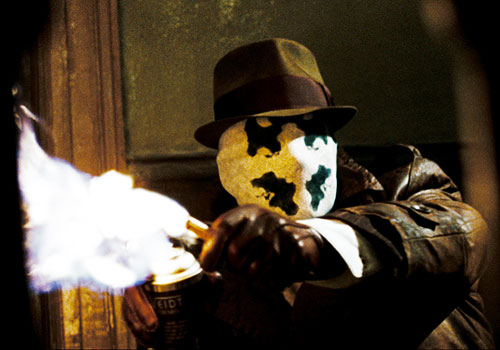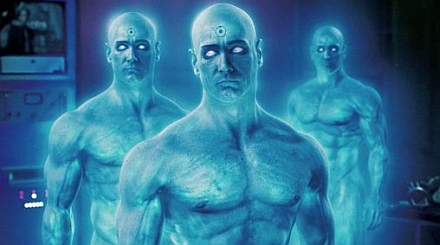

Director: Zach Snyder, 2009.
Snyder has done what many thought impossible: turned Watchmen into a movie that is faithful to the novel. Alan Moore's book has been called the greatest graphic novel of all time. It is certainly no comic book story. Rather, it is dense and deep, with sidebar articles that provide backstory for many of the characters that shed light on the mystery itself. Most of these sidebars have disappeared to make this film a reasonable length. Still, it runs almost three hours, a dark and gritty, violent and gory tale that will surely satisfy fans of the graphic novel. For those who have not read this modern classic, the film may be a little confusing.
It is 1985 and an alternate America where Nixon is President for a third term. The cold war is still hot and the world is on the brink of nuclear destruction. Society has descended into depravity and despair. There is a need for a savior.
 At the start, Snyder gives a montage of images that paint the history of America since WW2. Masked vigilantes emerged to watch over society. These so-called superheroes are merely men and women who are prepared to fight crime, for one reason or another. One image shows a group of these watchmen together at a retirement party. This party photo is a recreation of Leonardo Da Vinci's "The Last Supper" and is clearly painting the parallel to Christ and his disciples. Yet, missing from the picture is the Christ figure. He will show up later.
At the start, Snyder gives a montage of images that paint the history of America since WW2. Masked vigilantes emerged to watch over society. These so-called superheroes are merely men and women who are prepared to fight crime, for one reason or another. One image shows a group of these watchmen together at a retirement party. This party photo is a recreation of Leonardo Da Vinci's "The Last Supper" and is clearly painting the parallel to Christ and his disciples. Yet, missing from the picture is the Christ figure. He will show up later.Snyder employs songs from the 60s-80s on the soundtrack to perfectly match the mood and tone of the film. Bob Dylan's "The times they are a changing" takes us from these histories to 1985 and underscores the pint that change has come. The government has passed a bill outlawing masked men. Their days of vigilante justice are gone. Capes are hung up, masks removed. Superheroes are retired. Yet still society is under attack.
 Snyder paints a dark picture of humanity. The rule of mob law and the depravity of the superheroes themselves points to the savage nature of mankind. This is an exaggerated but sadly true picture of humanity. We are depraved (Jer. 17:9), we are tainted by sin. None has lived a righteous life (Rom. 3:10); all have turned away from God (Isa. 53:6).
Snyder paints a dark picture of humanity. The rule of mob law and the depravity of the superheroes themselves points to the savage nature of mankind. This is an exaggerated but sadly true picture of humanity. We are depraved (Jer. 17:9), we are tainted by sin. None has lived a righteous life (Rom. 3:10); all have turned away from God (Isa. 53:6).So when the Comedian, Edward Blake (Jeffrey Dean Morgan), is brutally murdered in his high-rise apartment, the other watchmen start to wonder if it is a conspiracy to kill them all. Rorschach (Jackie Earle Haley), another superhero wearing a mask that mutates in rorschach ink-blot patterns, is determined to solve the mystery. And it brings him back in touch with an old partner Dan / Nite Owl (Patrick Wilson). The watchmen start to reconnect with each other: Ozymandias (Matthew Goode, Brideshead Revisited), the smartest and wealthiest man alive; Laurie / Silk Spectre II (Malin Akerman, The Proposal), and her lover Dr. Manhattan (Billy Crudup).
 Although these superheroes want to make the world a better place, their motives are mixed and so are their methods. Rorschach lives with the principle, "Never compromise. Not even in the face of Armageddon." He wants to exercise justice on the unjust, the lowlife criminals, but he does so without mercy or compassion. There is nothing that separates him from those he is trying to rid society of. Justice is one thing, justice tempered with grace is quite another.
Although these superheroes want to make the world a better place, their motives are mixed and so are their methods. Rorschach lives with the principle, "Never compromise. Not even in the face of Armageddon." He wants to exercise justice on the unjust, the lowlife criminals, but he does so without mercy or compassion. There is nothing that separates him from those he is trying to rid society of. Justice is one thing, justice tempered with grace is quite another.Ozymandis believes that the solution to war is to find enough resources to go around. If he can rid the world of its reliance on oil and fossil fuels, he can bring in a utopia. What a dream! He does not count on the darkness that lives within the human heart (Rom. 1:21). That cannot be cured by a socialist approach. It requires a savior's touch.
 Throughout Snyder intersperses brief vignettes showing us who the watchmen really are. Comedian, the first to die, is the only government-endorsed superhero. But, who watches the watchment? The Comedian is actually a psychopath who relishes societal violence as an opportunity for him to exercise violence on others. We see him enjoying the killing fields of Vietnam and showing no remorse while coldly gunning down a lover.
Throughout Snyder intersperses brief vignettes showing us who the watchmen really are. Comedian, the first to die, is the only government-endorsed superhero. But, who watches the watchment? The Comedian is actually a psychopath who relishes societal violence as an opportunity for him to exercise violence on others. We see him enjoying the killing fields of Vietnam and showing no remorse while coldly gunning down a lover."Who watches the watchman" dates back to Aristotle who coined this phrase in response to Plato's theory of the filakes, the ancient watchmen who would be the ultimate, infallible authority in the perfect city-state (see "The Republic"). But who really watches the watchmen? When we give too much power to those who are supposed to be protecting us, we run the risk of corrupting those very people we trust. The watchmen in this story are not perfect. They are people with flaws and weaknesses. They are, in some cases, worse than the worst of society. And they get off on the power that is thrust on them. No one, so it seems, is watching these watchmen. But someone is. And that someone is killing them off. Who and why is the mystery that Rorschach, Nite Owl and Silk Spectre II set out to solve.
Of all the superheroes, there is only one who actually has super powers -- Dr. Manhattan. His backstory is given midway through the film. A physicist Jon Osterman gets locked into a lab when a field energy experiment is underway and his body is vaporized only to become reassembled later. When he returns, he is transformed into a huge naked blue being who can change matter. He can mentally transport himself or others to any place he desires. Used initially by the government to win the Vietnam war, he becomes more and more distant from his lover, Laurie, until she leaves him.
 It is Dr. Manhattan who is the missing Christ-figure. Referring to him, one of his friends says, "I did not say there is a superman and he is American. I said there is a God and he is American." From superman to god, he is deified. And no wonder, he can see past, present and future. He can manipulate matter. He can materialize anywhere he wants. He can split into multiple beings, a veritable holy trinity of blue Jons.
It is Dr. Manhattan who is the missing Christ-figure. Referring to him, one of his friends says, "I did not say there is a superman and he is American. I said there is a God and he is American." From superman to god, he is deified. And no wonder, he can see past, present and future. He can manipulate matter. He can materialize anywhere he wants. He can split into multiple beings, a veritable holy trinity of blue Jons.Before the advent of cgi filming, the special effects needed for Dr. Manhattan would have been difficult and overly expensive. With today's technology Snyder pulls off a miracle making this god-like man believable. The scenes on Mars in his ice-palace take our breath away even as Laurie has no breath to take when she is transported there.
The comparison with Christ is clearly worth considering. Dr. Manhattan has resurrected from death to new life and, like Jesus, upon his return he is a new kind of body. Just as Jesus appeared in a room behind locked doors (Jn. 20:26), Dr. Manhattan can suddenly show up in a different place. Further, he was the savior for America in the Vietnam war and is their hope for peace and security amidst the cold war. And when it becomes clear that it requires a scapegoat to save earth from hell, Dr. Manhattan allows himself to be that scapegoat, just like Jesus is our scapegoat (Jn. 11:50).
But Jesus is not a nationalistic savior. Though a Jew and sent to the Jews, Jesus is the savior of the whole world (Jn. 3:16). He is our hope (1 Tim. 4:10), our peace (Jn. 14:27), our security (Psa. 18:2) amidst all human wars.
Indeed Dr. Manhattan is not God, and the contrasts are clear. He was born a man, and is thus a creature. Christ, on the other hand, pre-existed creation (Jn. 1:1). He has always existed and is the creator not one of his created beings. In his new super-body, Dr. Manhattan can see the past, present and future. But he can only see his, not that of others. And when tachyons are used, they shield even his future so he cannot see what is coming. Whereas God can see all of time for all of us. Further, Dr. Manhattan says, in one scene, "I am tired of her, of these people, of the tangle of their lives." He has lost interest in humanity -- "Why would I save a world I no longer have a stake in?" God, on the other hand, is so involved with humanity that he sent Jesus to became one of us, descending from his position on the throne of God (Phil. 2:5). He loved us so much he went to the cross giving up his life for us.
Finally, Dr. Manhattan says, "I can change almost anything . . . but I can't change human nature." How unlike Christ. He who made us innocent (Gen. 2:25), saw mankind become corrupt and sinful (Rom. 3:12). He watched us turn away from God in our savage nature (Gen. 3:1-11). But through his sacrifice, he can change human nature. He can make us into new creatures with a new nature if we turn to him (Jn. 1:12). He can re-create us (2 Cor. 5:17), and to those who become his followers he will mold us into his perfect image (Rom. 8:29). And he has placed in us his Holy Spirit (Jn. 14:16-17). God now lives in us, his followers, not in Dr. Manhattan.
When it all comes to a close, we are reminded that there is only true watchman, one true savior. He stands apart from the rest in his personal involvement. He is the craftsman that has created all and he desires for this creation to be remade (Rom. 8:18-24). One day he will return and peace will be established. Until then, let's put our hope in our Watchman.
Copyright ©2009, Martin Baggs

http://reallifesuperheros.org
ReplyDelete